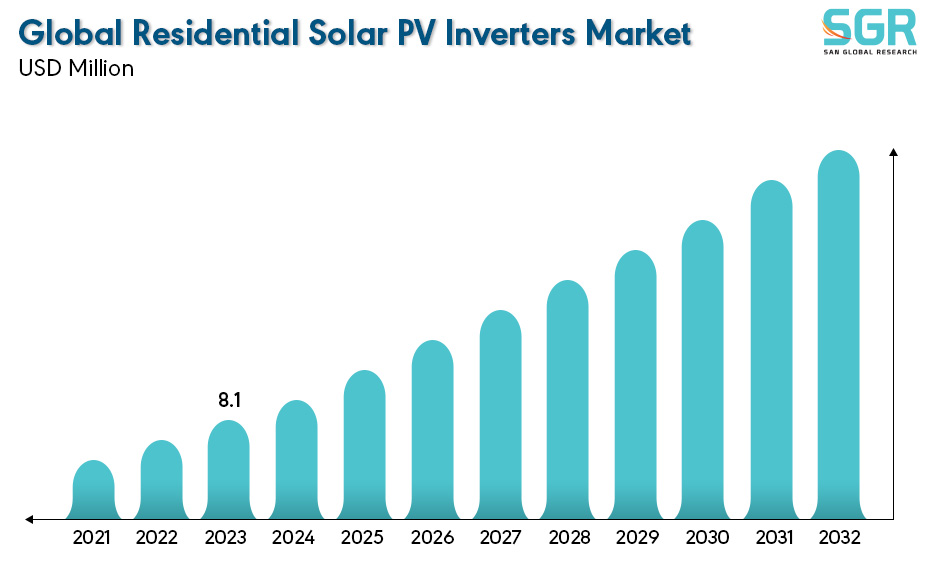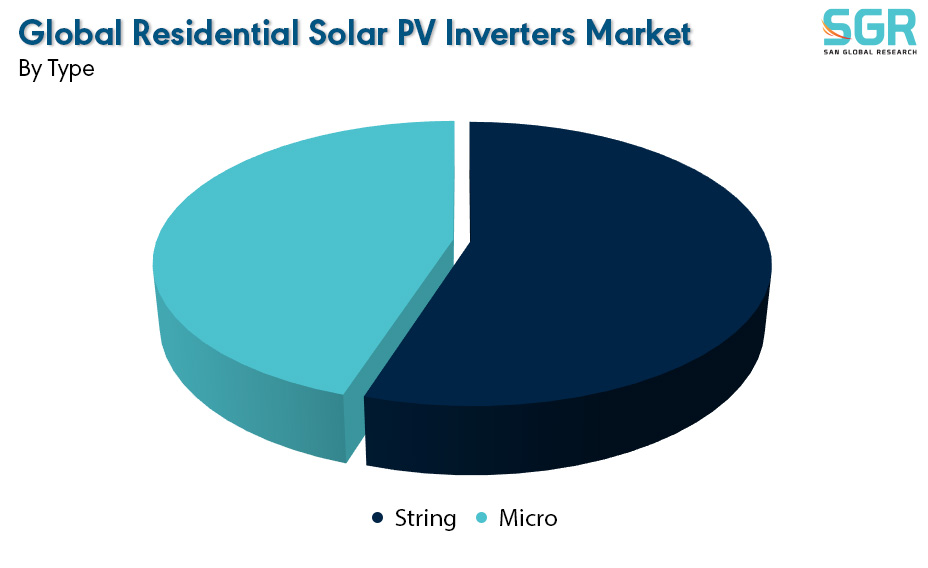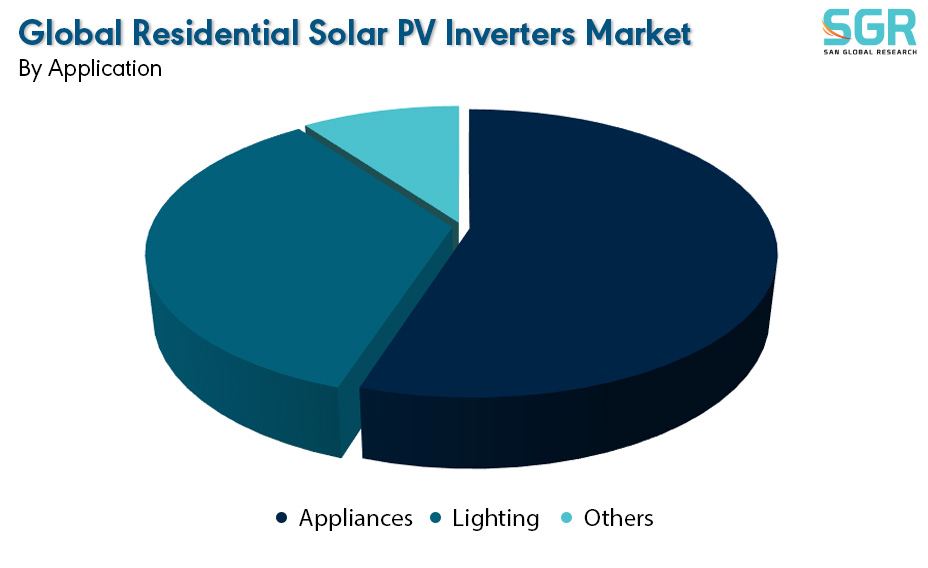Global Residential Solar PV Inverters Market is estimated to be worth USD 8.1 Billion in 2022 and is projected to grow at a CAGR of 7.4% between 2023 to 2032. The study has considered the base year as 2022, which estimates the market size of market and the forecast period is 2023 to 2032. The report analyzes and forecasts the market size, in terms of value (USD Billion), for the market. The report segments the market and forecasts it by Type, by Application and by region/country.

The residential solar PV inverters market is a critical component of the broader solar energy sector, focusing specifically on converting direct current (DC) electricity generated by solar panels into alternating current (AC) electricity suitable for use in homes. These inverters play a pivotal role in maximizing the efficiency of residential solar photovoltaic (PV) systems. As the global shift towards clean and sustainable energy sources gains momentum, residential solar PV installations have seen widespread adoption. The market for inverters has witnessed significant advancements in technology, with the introduction of smart and grid-tied inverters that enhance monitoring capabilities and allow homeowners to integrate their solar systems with the broader electrical grid. The residential solar PV inverters market is driven by factors such as government incentives, declining solar panel costs, and increased awareness of environmental sustainability. As residential solar installations continue to grow, driven by both economic and ecological considerations, the demand for efficient and reliable PV inverters is expected to rise, shaping the trajectory of the residential solar PV inverters market.
.jpg)
Region wise Comparison:
The residential solar PV inverters market in North America is experiencing robust growth, driven by a combination of factors such as favorable government incentives, increasing awareness of clean energy, and the declining cost of solar installations. Homeowners are adopting solar PV systems, and the demand for efficient inverters is rising. Technological advancements, including smart inverters and energy storage solutions, contribute to the market's dynamism.
In Europe, the residential solar PV inverters market is thriving, propelled by the region's commitment to renewable energy and sustainability goals. Various European countries have implemented supportive policies, feed-in tariffs, and net metering schemes, encouraging residential solar installations. Smart grid initiatives and advancements in inverter technologies, enabling better grid integration and energy management, are shaping the market.
.jpg)
The Asia Pacific region is a key player in the residential solar PV inverters market, led by the rapid adoption of solar energy solutions in countries like China, India, and Australia. Government initiatives, such as subsidies and incentives, drive the market, making solar installations more accessible to homeowners. Technological innovations, particularly in grid-tied and hybrid inverters, cater to the diverse energy needs of households in the region. The sheer scale of residential solar adoption in Asia Pacific contributes significantly to the growth of the solar PV inverters market.
In Latin America, the residential solar PV inverters market is gaining traction as countries embrace solar energy as a viable source of power. Supportive regulatory frameworks, coupled with decreasing solar equipment costs, encourage residential solar installations. The market benefits from the region's abundant sunlight and increasing environmental consciousness.
The residential solar PV inverters market in Africa and the Middle East is gradually emerging, driven by a growing interest in clean energy solutions. While solar adoption varies across countries in these regions, increased urbanization and the quest for energy independence contribute to the market's development.
.jpg)
Segmentation:
The Global Residential Solar PV Inverters Market is segmented by Type, by Application and by region/country.
By Type:

Based on the type, the Global Residential Solar PV Inverters Market is bifurcated into String & Micro – where String is dominating and ahead in terms of share.
In the Residential Solar PV Inverters Market, string inverters represent a popular and widely used technology for converting direct current (DC) electricity generated by solar panels into alternating current (AC) suitable for residential use. String inverters are designed to manage multiple solar panels connected in series, forming a "string." This design allows for a cost-effective and efficient solution, particularly in residential installations where space and budget considerations are critical. One of the advantages of string inverters is their simplicity and ease of installation, making them suitable for a wide range of residential solar projects.
By Application:

Based on the Application, the Global Residential Solar PV Inverters Market is bifurcated into Appliances, Lighting & Others – where Appliances is dominating and ahead in terms of share.
On the basis of region
• North America
• Europe
• Asia Pacific
• South America and
• Middle East and Africa
In 2022, North America is anticipated to dominate the Global Residential Solar PV Inverters Market with market revenue of XX USD Million with a registered CAGR of XX%.
Key Players:
The key market players operating in the Global Residential Solar PV Inverters Market include
• General Electric
• SMA Solar Technology AG
• Sungrow
• Schneider Electric
• Enphase Energy
• Siemens
• Fimer Group
• SolarEdge Technologies
• Huawei Technologies
• Fronius International GmbH
Drivers:
Growing sector across the globe
The Residential Solar PV Inverters Market is driven by several key factors contributing to the widespread adoption of solar energy solutions in residential settings. Government incentives and policies promoting renewable energy, including tax credits and feed-in tariffs, play a pivotal role in encouraging homeowners to invest in solar PV systems. The declining costs of solar installations, coupled with increased awareness of environmental sustainability, further propel the market. Technological advancements in solar PV inverters, such as the development of smart inverters with enhanced monitoring and control capabilities, contribute to the market's growth by providing homeowners with more efficient and intelligent energy solutions. Rising electricity prices, grid unreliability, and a desire for energy independence also act as significant drivers, prompting households to turn to solar power and driving the demand for residential solar PV inverters. Overall, the Residential Solar PV Inverters Market is strongly influenced by a combination of economic, environmental, and technological factors that continue to foster its expansion.
Opportunity:
Evolving Market
The Residential Solar PV Inverters Market presents a host of opportunities aligned with the global shift towards clean and sustainable energy. One notable opportunity lies in the continued growth of residential solar installations as homeowners increasingly seek to reduce their carbon footprint and lower energy costs. The integration of energy storage solutions with solar PV inverters presents another avenue for innovation, allowing homeowners to store excess energy for later use and enhance grid resilience. Technological advancements, including the development of more efficient and intelligent inverters with advanced monitoring and control capabilities, provide opportunities for manufacturers to differentiate their products. Moreover, as governments worldwide continue to incentivize renewable energy adoption, the Residential Solar PV Inverters Market can capitalize on supportive policies, subsidies, and net metering programs. Collaborations between solar companies and utilities, along with advancements in smart grid technologies, open doors for further integration and optimization of residential solar systems. As the market evolves, opportunities abound for stakeholders to contribute to the growth of residential solar PV inverters by embracing innovation, sustainability, and enhanced energy management solutions.
| Report Attribute | Details |
| Market Value in 2022 | 8.1 Billion |
| Forecast in 2032 | 14.5 Billion |
| CAGR | CAGR of 7.4% from 2024 to 2032 |
| Base Year of forecast | 2023 |
| Historical | 2019-2022 |
| Units | Revenue in USD Billion and CAGR from 2023 to 2032 |
| Report Coverage | Revenue forecast, Industry outlook, competitive landscape, growth factors, and trends |
| Segments Scope | By Type, By Application |
| Regions Covered | North America, Europe, Asia Pacific, SA and MEA |
| Key Companies profiled | • General Electric • SMA Solar Technology AG • Sungrow • Schneider Electric • Enphase Energy • Siemens • Fimer Group • SolarEdge Technologies • Huawei Technologies • Fronius International GmbH |

 Description
Description
 Table of Content
Table of Content
 Gera Imperium Rise,
Gera Imperium Rise,  +91 9209275355
+91 9209275355


